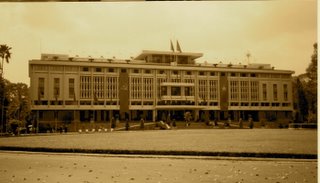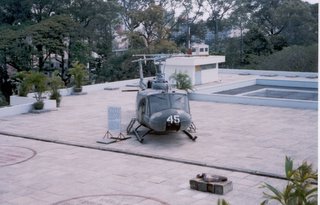A Short History of Vietnam

One of the must-see sights for any visit to Ho Chi Minh City is the Reunification Palace. A trip to this historical building will give insight into Vietnamese history, nationalism, and architecture, as well as the life of the political leadership up to the end of the war.
Over the course of its lifetime the building has been renamed twice and rebuilt once. The building was first built between 1868-71 after the founding of the Union of Indochina by the French imperialists. It was named Norodom Palace, after the Cambodian King of the time, who had earlier signed a treaty recognizing French protection, and symbolized the authority of the French over the area.
After the French pulled out in 1954, the country became polarised along geographical lines. In the north, true liberation from international interference was achieved, but in the south the country traded French for US rule. Although obstensible less involved, the US installed their own choice of leader, Ngo Dinh Diem, who refused to carry out the Geneva Agreement pledge to hold free elections, and ruled in a authoritarian and nepotistic fashion. He renamed the Norodom Palace as the Independence Palace--without any sense of irony.
Discontent spread rapidly, and in 1962 there was an attempted military coup. Two AD-6s dropped bombs on the Independence Palace, destroying a large part of the west wing, but leaving Diem unscathed. Seeing the building was beyond repair, Diem ordered it to razed and rebuilt in a new style. Unfortunately for Diem, he never got to see the Rome Laureate award-winning building, being assassinated just over a year after the construction work began.
This is the building that still stands today. A blend of modern architectural style and Oriental elements, covering 20,000 sq. meters and including 95 rooms on four floors. Maybe if Diem's design had been less grand he might've got to see it.
On April 30, 1975 the Independence Palace had its fifteen minutes of world fame. After battling their way to Saigon, the Liberation Army finally arrived at the political headquarters of the South Vietnamese. Tank No. 390 crashed through the main gates and pulled up outside the palace. A solider ran to the top floor and pulled down one flag and rasied another.
The war was over.
No longer would a president live or rule here. The Independence Palace was renamed the Reunification Palace and it stands to this day with the same name, a constant memorial to Vietnam's turbulent past.
I arrived a few little before 1pm, getting hassled by cyclo-drivers, coconut sellers and kids selling sets of postcards while I waited for the Palace to open. Again visitors are given the tour-guide treatment, but this time I slipped away and did my own exploring. The rooms are eerie, considering this is where people once lived. Immaculate furniture, polished floors, cavernous halls with high ceilings. I can't imagine anyone could actually relax here. It's more like a museum than a living space.
Or the unfleshed out idea of a child megalomaniac. Labyrinth basement. Check. Escape tunnel. Check (although it was never finished, leading nowhere). Hi-tech gadgets. Check. Helipad. Check. Massive chambers with no obvious purpose. Check. Spooky.
Travelling alone gives you plenty of time for self-reflection. In these beginning days of the trip I often felt isolated. There were hundreds of other tourists around but I wasn't making the effort to meet them. I expected people to come to me without really appreciating that it takes effort on their part to do that. I started to wonder how other people perceived me.
In some ways it's good not to be concerned about other's opinions of oneself. Otherwise, you can become wrapped-up in your outward appearance while your inner life is neglected. However, considering how others look at you can help empathise with other people's perspective, and help you shape your own life.
So how did I think people were perceiving me?
Independent-minded, reserved, a little tense, maybe boring -- my intonation is pretty flat, and the way my brain works means that I'm terrible at relating stories in speech (I generalise, mix-up the chronology, forget the punchline etc), in fact in the TEFL teacher training I completed in 2005 my delivery was still flagged as something which needed work. Of course, these are just aspects relating to first impressions. People who know me better have a different, or more meaningful, image of me--I hope!
But to get to know people you have to go through those first stages. With these thoughts in mind I made an effort to be more relaxed, less self-critical, more open, and add more expression and enthusiasm to my speech.



0 Comments:
Post a Comment
<< Home